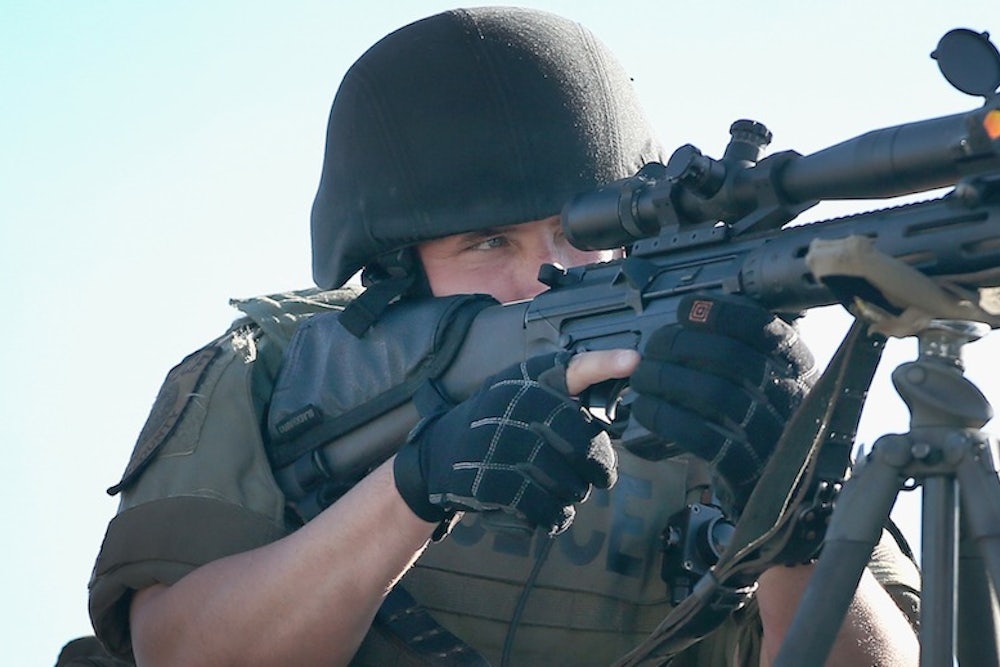Ferguson, Missouri turned into a war zone Wednesday night, with police unleashing tear gas, rubber bullets, and smoke bombs on protesters. It didn’t have to unfold that way.
Well-functioning police departments take steps in order to avoid precisely the kind of escalation that took place. That includes holding officers accountable for their actions after-the-fact, obviously. But it also includes lots of preparation, in order to make sure police know how to control crowds with only the force necessary to maintain order and keep the peace. As Margo Schlanger, a University of Michigan law professor and former police department investigator for the Department of Justice, explains, “There are lots of things other than discipline to hold a police agency accountability—training and retraining, thinking about incidents in a way that’s sort of problem solving in a way.”
Here are some of those steps:
1. Spend five to fifteen minutes on force training every day: A specific type of police training, called roll call training, involves issuing brief refreshers on good policing practices. In addition to keeping the officers informed, it lets supervisors zero in on potential problem areas. Topics might include when it’s appropriate to use a taser, if it’s okay to point a gun at a person, and what exactly constitutes protected speech. With the right training, for example, cops should know that videotaping police is not generally grounds for arresting citizens and journalists, who do have constitutional rights to record.
2. Make officers file reports for every use of force, even seemingly small ones: Requiring officers to fill out a for every single time they use force is another good practice. Typically, departments will require officers to report any use of force—not just firing a gun or using tear gas, but also the simple act of aiming a weapon at somebody. Simply requiring such reports can have a powerful deterrent effect, reminding officers using force should be a rare occurrence.“Part of the point of use of force reporting is to remind your officers that force is not routine,” Schlanger said. “Force is really serious. When the state summons up force against one of its citizens, that’s a big deal.”
How departments treat the reports is also important. Supervisors should use them to spot problems before they become trends. Force will be justified in plenty of instances, of course. But the reports will bring to light those uses that are questionable—and, at the very least, give supervisors opportunities to discuss those incidents. In some instance, those conversations will lead to new practices designed to help officers avoid volatile situations in the first place.
3. Ditch the riot gear: St. Louis County's police were outfitted in full riot gear with military-grade protection and weapons. That anonymity tends to only escalate crowd conflict and violence, according to research posted on the FBI’s website. Experts agree that, except in cases where physical threat requires such extensive protection, there is a better way: Police should engage crowds peacefully, wearing identifiable badges and nametags, and try to communicate. The authors of the book Preventing Crowd Violence find that police behavior plays a critical role in crowd behavior—it can incite or it calm. “If crowd participants feel police actions against the crowd are overly severe or unprovoked, individuals will be more likely to contribute to violent acts to resist the police,” the authors said.
4. Add a video camera: Dash cams on patrol cars, a relatively recent innovation, have done more than record police encounters. They’ve also changed police behavior. As Ian Millhiser at ThinkProgress has written, research shows police engage in less misconduct when they realize they are being watched. But the cams don’t have to be on cars. They can be on people, too. Some departments already outfit their officers with uniform-mounted cameras. And the results have been similar. A 2013 study of Rialto, California’s police department saw there was twice as many use of force incidents for police who didn’t wear cameras on their shifts as the ones who did.
My efforts to reach a spokesman for the Ferguson police were unsuccessful, so it is possible they already had one or more of these policies in place. But we know for sure at least one was not: The cameras. According to the Washington Post’s Wesley Lowery, Ferguson never installed theirs, despite receiving a Department of Justice grant for two dash cams and two officer cameras. That is why there's no video of the officer shooting Michael Brown. Of course, had it been there, maybe the shooting never would have taken place.
